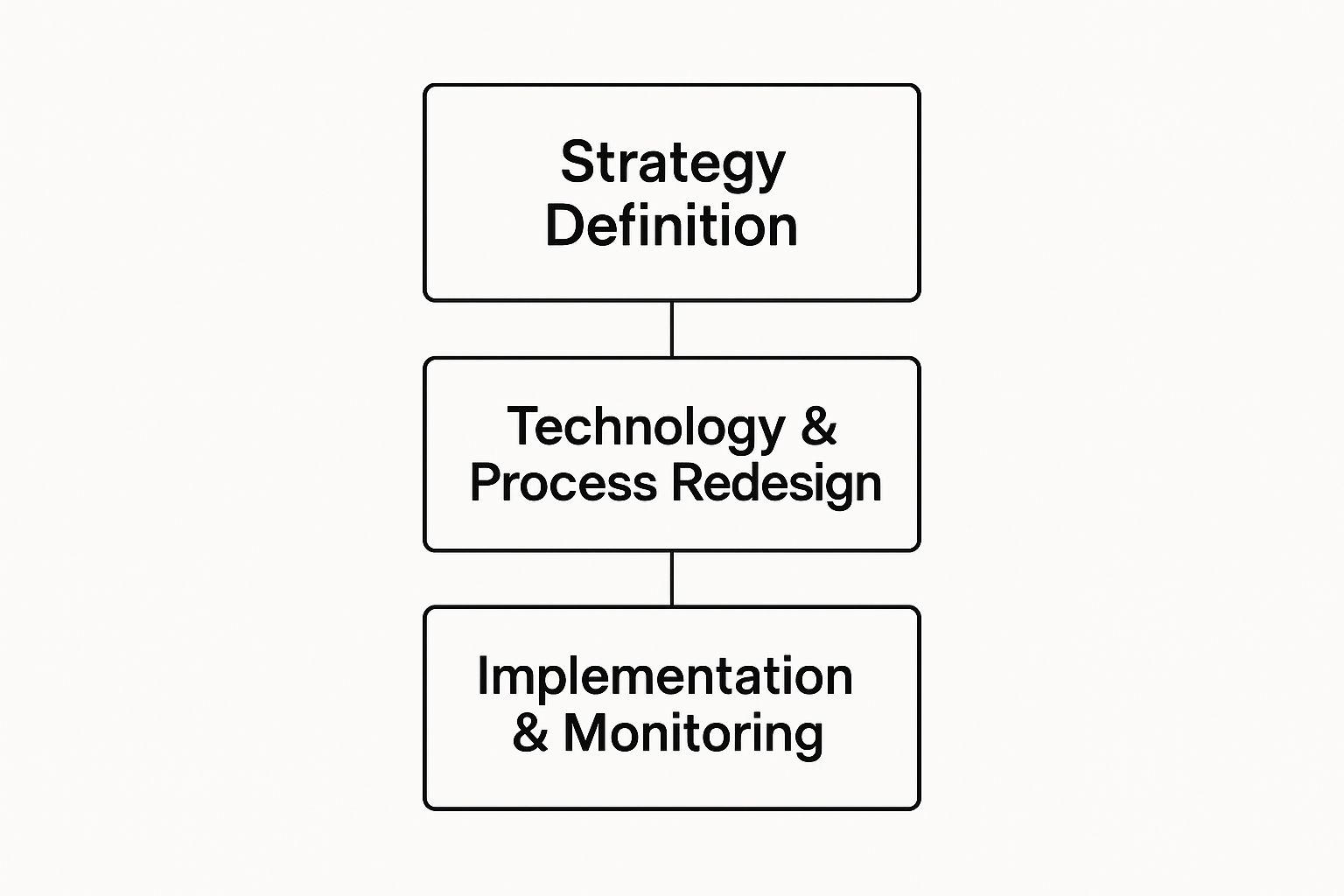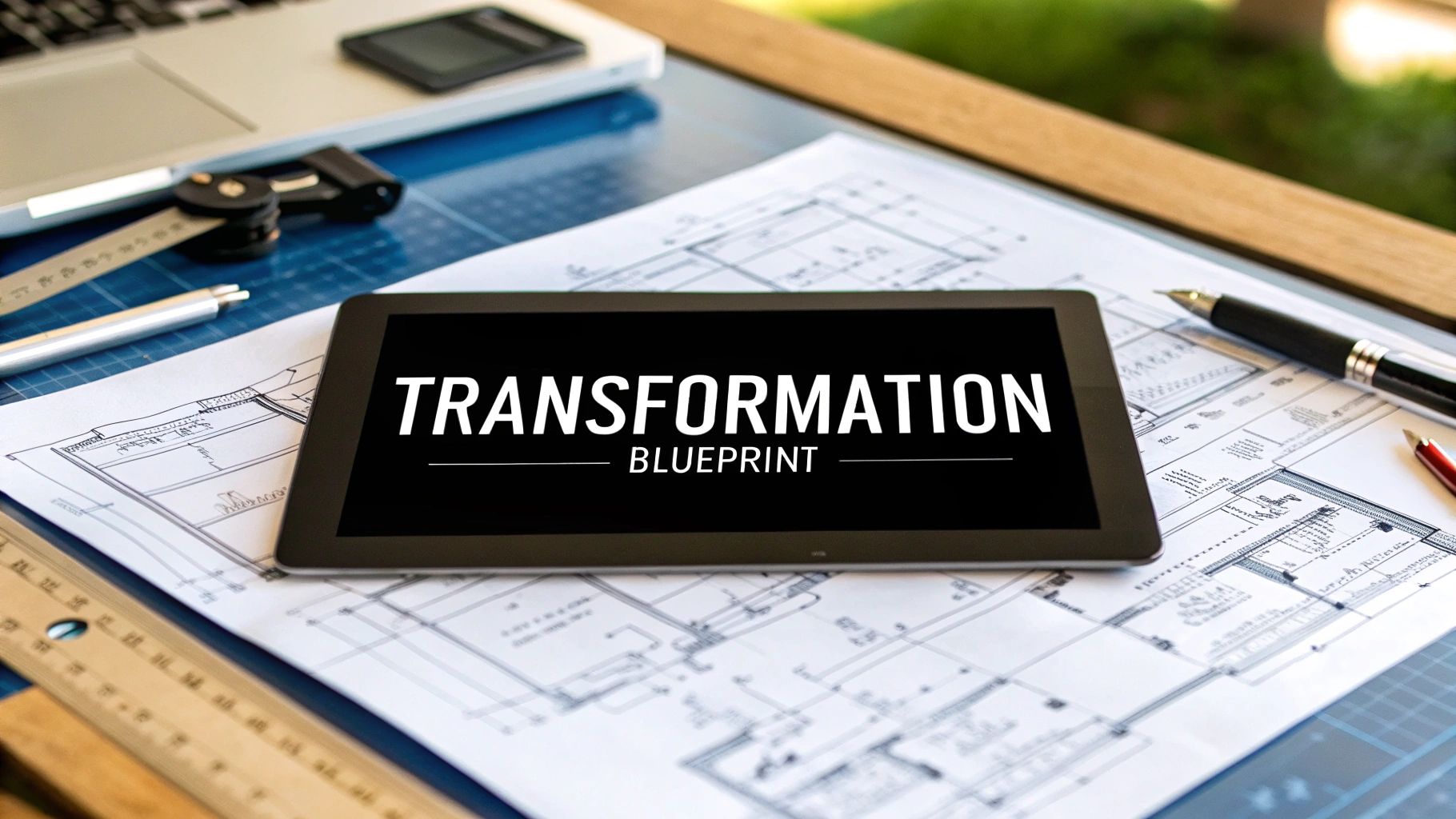So, what exactly is a digital transformation strategy? At its heart, it's a detailed blueprint that fundamentally changes how you run your business and, more importantly, how you deliver value to your customers.
This isn't just about buying the latest software or moving to the cloud. It’s a complete reimagining of your company’s culture, core processes, and customer experiences to thrive in a digital-first world. This strategy is your master plan for survival and growth.
Beyond Buzzwords: Understanding Your Digital Blueprint
Many leaders think they have a strategy when all they've really done is purchase new technology. Let’s use an analogy: imagine you’re renovating an old house. You can fill it with shiny, high-tech appliances, but those gadgets won't fix cracked foundations or leaky, outdated plumbing. A real renovation requires a detailed architectural plan—a strategy—that rethinks everything from the wiring (your data infrastructure) to the overall floor plan (your customer journey).
A digital transformation strategy does the exact same thing for your business. It’s the plan that aligns your technology, people, and processes toward a single, unified vision. It ensures that every digital project you undertake actually contributes to meaningful, long-term business goals.
What Makes a Strategy a Strategy?
A genuine strategy is far more than a to-do list of tech upgrades. It's a cohesive plan that directly connects your investments to specific business objectives. You'll find it usually includes a few critical components:
- A Clear Vision: This defines what your business will look like after the transformation. For a retailer, this could mean evolving from a traditional brick-and-mortar focus to creating a seamless, unified experience across online and in-store channels.
- Customer-Centric Focus: The strategy reorients the entire organization around delivering an exceptional customer experience. It’s about using data to understand what your customers want, sometimes even before they know it themselves.
- Operational Agility: It involves redesigning old, clunky workflows to be faster, more efficient, and driven by data. This newfound agility allows the business to pivot quickly in response to market shifts and jump on new opportunities.
A digital transformation strategy is less about what technology you buy and more about how you use it to create a real competitive advantage. It’s the intentional rewiring of a business to operate at the speed of modern customer expectations.
To give you a sense of how seriously businesses are taking this, consider the numbers. By 2025, global spending on digital transformation is projected to hit a staggering $2.8 trillion. This isn't just a trend; it's a fundamental shift. That massive investment shows that having a well-defined plan is now the baseline for competing in any industry, from manufacturing to healthcare.
Here's a quick breakdown of the core elements that make up a robust strategy.
Core Components of a Digital Transformation Strategy
This table summarizes the essential parts of a digital transformation strategy, breaking the concept down into actionable pieces.
| Component | What It Means | Example |
|---|---|---|
| Vision & Leadership | Defining the "why" and securing executive buy-in. | A CEO champions the vision of becoming a "data-first" organization. |
| Customer Experience | Mapping and enhancing every customer touchpoint. | Implementing a unified CRM to provide a single view of the customer. |
| Operational Processes | Automating and streamlining internal workflows. | Using RPA to automate manual data entry in the finance department. |
| Technology & Data | Building the right tech stack and data infrastructure. | Migrating from on-premise servers to a scalable cloud platform. |
| Culture & People | Fostering a mindset of innovation and continuous learning. | Launching digital literacy training programs for all employees. |
Each of these components is crucial. A strategy that focuses only on technology but ignores culture is just as likely to fail as one with a great vision but no plan for execution.
Ultimately, this plan is about building a resilient, modern organization. For a deeper dive into what truly defines effective digital transformation strategies that go beyond just adopting technology, it's worth exploring additional expert resources. They can provide the context you need to build a plan that delivers real results, moving your business from simply doing digital things to truly being digital in its DNA. It’s this core change that separates industry leaders from those who get left behind.
Why a Digital Strategy Is No Longer Optional

Not long ago, having a great website or a solid social media presence was a fantastic way to get ahead of the competition. It was a clear advantage. But that world is gone.
Today, a well-thought-out digital transformation strategy isn't about outperforming your rivals; it's about basic survival. The ground has shifted so fundamentally that businesses unwilling or unable to adapt are finding themselves on very shaky footing.
So, what's driving this urgency? It really boils down to one thing: a massive shift in customer expectations. We all now live in a world of on-demand everything, where giants like Amazon and Netflix have completely rewired our brains. We expect seamless, personal, and instant service from every single company we interact with, no matter the industry.
A clunky website, slow response times, or a broken mobile app aren't just minor frustrations anymore. They are deal-breakers. In fact, studies show that 88% of consumers are less likely to come back to a website after a bad experience. That's an enormous—and entirely avoidable—cost of digital inaction.
The Rise of the Digital-Native Competitor
As if rising customer demands weren't enough, there's another constant pressure: the new kids on the block. Digital-native startups and agile scale-ups were literally born in this era. They carry no baggage from old systems, clunky processes, or a "this is how we've always done it" mindset.
They can innovate, test, and pivot to meet market needs at a speed that can be dizzying for established companies.
For a legacy business, trying to compete against these nimble players without a coherent digital strategy is like showing up to a Formula 1 race with a horse and buggy. They are simply built for the modern economy. Their very presence forces everyone else to either transform or risk becoming irrelevant.
The question for any business today isn't if it should transform, but how fast it can execute a plan to stay in the game. Sticking with the status quo is a surefire way to be outmaneuvered.
This reality creates a sharp divide between organizations that lean into change and those that fight it. The consequences for falling on the wrong side of that divide are getting more severe by the day.
The Real-World Payoff of Going Digital
But this isn't just about dodging a bullet; it's about unlocking incredible new potential for growth and stability. A smart digital strategy delivers tangible results that don't just help a company survive, but thrive.
Here’s what that looks like in practice:
- Staying Relevant: By using digital tools to truly listen to your customers, you can build products and services they actually want. This is how you remain their first choice when they have a sea of options.
- Building Fierce Loyalty: When you create a smooth, personalized experience at every turn, you build powerful relationships. Customers who feel seen and understood will stick with you, even if a competitor dangles a lower price.
- Becoming More Agile: Modernizing your internal operations with automation and smart data helps you run a tighter ship. This agility is what allows you to respond to surprises, whether it’s a supply chain hiccup or a sudden change in what your customers want. There's a whole world of modern digital activities that companies are using to build this operational muscle.
Think about the retail industry. The old-school, brick-and-mortar stores that dragged their feet on e-commerce got hammered. But the ones that integrated their physical and online worlds flourished. They used their strategy to roll out features like "buy online, pick up in-store," personalized offers through mobile apps, and smarter inventory management based on real-time data.
These successful businesses didn't just digitize what they were already doing; they completely reimagined how they could serve their customers. In the end, that's what a digital transformation strategy is: a roadmap for reinvention. It's the deliberate plan to build a company that can succeed not just today, but long into an unpredictable future. Without one, you're just waiting for the next disruption to arrive.
The Four Pillars of Successful Transformation
A truly effective digital transformation strategy isn't built on a single great idea or a powerful piece of software. It’s a balanced structure supported by four essential pillars. Think of it like building a high-performance car: a powerful engine is useless without a strong chassis, responsive steering, and a driver who knows how to handle it.
Each pillar is completely interdependent. When one is weak, the entire structure becomes unstable. When all four work in harmony, they create a powerful engine for sustainable growth and a genuine competitive edge. Let’s break down what each of these pillars involves.
Technology and Data Integration
This is the pillar everyone sees first: Technology and Data Integration. It's the technical backbone of your entire strategy, covering all the tools, platforms, and infrastructure you put in place. But it’s about so much more than just buying new software; it's about making sure all your systems can actually talk to each other and share information without a hitch.
A few key areas fall under this umbrella:
- Cloud Computing: Getting away from rigid, on-site servers and moving to flexible, scalable cloud environments that can grow and shrink with your business needs.
- Data Analytics: Putting tools in place that can gather, process, and make sense of massive amounts of data to give you real insights into your customers and how your business runs.
- Automation: Using software to take over the repetitive, manual tasks that bog your team down, freeing them up to focus on strategic work that actually matters.
A well-integrated technology stack acts as the central nervous system of your business. It ensures that the right information gets to the right people at the right time, enabling smarter, faster decisions across the board.
Artificial intelligence, in particular, is a huge driver here. AI and related technologies are profoundly shaping how companies approach their transformation plans. By 2025, it's expected that generative AI tools will lead the charge by automating complex jobs, like processing insurance claims or gathering project requirements. This kind of automation could shorten project timelines by as much as 50% and cut delivery costs by around 40%. You can learn more about these digital transformation findings and what they mean for businesses.
Process Modernization
Next up is Process Modernization, which is all about rethinking how work actually gets done. It’s a classic mistake to just layer new technology on top of old, clunky workflows. That’s like putting a jet engine on a horse-drawn cart—you’ll just create a mess faster.
Real modernization means you have to re-examine your core operations from the ground up to make them quicker, more agile, and completely focused on the customer. This is where you break down the walls between departments, get rid of pointless steps, and build workflows designed for a digital world from the start.
A perfect example is a bank ditching its old paper-based loan application. They don't just scan the old forms. They redesign the whole experience with an online portal, automated credit checks, and e-signatures, slashing approval times from weeks to mere minutes.
This diagram shows how a strategy moves from a high-level idea to real-world action, with process redesign being that critical link in the middle.

As you can see, redesigning your technology and processes is the bridge that connects your big-picture goals to the nitty-gritty of implementation and measurement.
Culture and People
This might be the most important—and easily the most difficult—pillar: Culture and People. You can have the best tech and the slickest processes, but your transformation will completely stall if your team doesn't have the right mindset and skills. This pillar is about nurturing a company culture that welcomes change and empowers people.
To get there, you need a few things:
- Leadership Buy-In: The change has to be championed from the very top. Leaders need to be constantly communicating the vision and living the behaviors they expect to see.
- Employee Empowerment: Give your people the training, tools, and freedom they need to try things, learn, and adapt on their own.
- Fostering a Growth Mindset: You have to encourage curiosity and continuous learning. It's about creating a safe space where people feel they can experiment and even fail without fear.
Without this cultural shift, you’ll face resistance at every single turn. Employees will see new technology as a threat instead of an opportunity, leading to abysmal adoption rates and a project that's dead on arrival.
Customer Centricity
Finally, everything you do has to be anchored by the fourth pillar: Customer Centricity. If your digital transformation doesn't lead to a better customer experience, you've completely missed the point. This pillar is about using your digital tools and data to truly understand your customers and then using that knowledge to improve every single interaction they have with you.
This goes way beyond just having a friendly customer service team. It’s about building a seamless, personalized, and consistent experience across every touchpoint—your website, mobile app, physical stores, and support channels. When you put the customer at the absolute center of your strategy, you guarantee that every dollar you invest and every process you change is driving toward the one goal that truly matters: delivering more value and earning their loyalty for the long haul.
Practical Frameworks for Building Your Strategy

Knowing the core pillars of digital transformation is one thing, but actually putting them into action is another challenge entirely. Without a solid blueprint, even the most exciting initiatives can fall into disarray and lose steam. The good news? You don't have to start from a blank page.
Proven, practical frameworks give you a roadmap to follow when planning and executing your strategy. These models are like guideposts on a long journey, helping you ask the right questions, organize your efforts, and make sure every decision pushes you closer to your ultimate business goals. They bring much-needed clarity to what can feel like a massive, complex undertaking.
Think of it like using a recipe. You might tweak the ingredients based on what you have in the kitchen (your company's unique needs), but the fundamental steps are already laid out. This structure ensures you don't miss a critical step, dramatically increasing your chances of success.
Finding a Starting Point with MIT Sloan's Framework
One of the most respected and easy-to-grasp models comes from MIT Sloan, which breaks down digital transformation into nine distinct building blocks. This framework is incredibly helpful because it organizes the entire puzzle into three manageable categories: customer experience, operational processes, and business models.
By looking at your business through these three lenses, you can start to systematically pinpoint opportunities for real change. The idea is to move beyond one-off projects and build a cohesive plan where every initiative supports the others.
For instance, you could use this framework to map out how a new CRM system (customer experience) feeds data into an automated supply chain (operational processes), which in turn enables a brand-new subscription service (business model). Each piece of the puzzle clicks into place.
The real power of a framework is that it forces you to think holistically. It stops you from focusing narrowly on a single piece of technology and instead encourages a big-picture view of how digital capabilities can fundamentally reshape your entire business.
These frameworks are also invaluable for getting leadership on board. A structured, well-thought-out plan is far more compelling than a random list of tech projects. It shows you have a clear vision and a logical path to get there. Of course, managing the technical side can get complicated, which is why many businesses bring in experts in managed IT services to handle the infrastructure, freeing up internal teams to focus on pure strategy.
Choosing the Right Framework for Your Business
No single framework is a perfect fit for every company. The right one for you will depend heavily on your organization's size, industry, digital maturity, and specific objectives. A massive enterprise grappling with decades of legacy systems needs a very different approach than a nimble startup building everything from scratch.
The key is to pick a model that resonates with your unique situation. Some frameworks are built for speed and agile implementation, while others are better suited for slow, methodical change in large, complex corporations.
To help you find the right fit, let's compare a few of the most popular approaches out there.
Comparing Digital Transformation Frameworks
This table gives you a side-by-side look at different strategic frameworks, making it easier to see which approach might work best for your business needs.
| Framework Name | Core Focus | Best For |
|---|---|---|
| MIT Sloan's 9 Blocks | A balanced view of customer experience, operations, and business models. | Organizations looking for a comprehensive, holistic starting point. |
| Gartner's DX Framework | Emphasizes a five-stage maturity model from ambition to scaling. | Large enterprises that need a structured, phased rollout plan. |
| Agile Transformation | Prioritizes iterative progress, flexibility, and cross-functional teams. | Startups and tech companies operating in fast-moving markets. |
| McKinsey's Four Dimensions | Focuses on strategy, capabilities, organization, and culture as key drivers. | Companies where cultural change and skill development are major hurdles. |
Ultimately, the best strategy for your business will probably pull in elements that make sense for you. Don't be afraid to combine ideas from different models to create a hybrid approach that fits your context. The goal isn't to follow a framework to the letter, but to use it as a tool to spark strategic thinking, guide your decisions, and keep everyone on the same page.
How Winning Companies Execute Their Strategy

It's one thing to talk about frameworks and pillars in theory. It’s another to see them in action. The real magic happens when a company takes these abstract ideas and turns them into tangible business outcomes. A successful digital transformation isn't a single, massive project; it's a series of smart, connected decisions that fundamentally change how a business operates.
By looking at real-world examples, we can see how these principles come to life across different industries. Whether it's retail, manufacturing, or finance, the core idea is the same: pinpoint a major pain point, apply the right technology to solve it, and measure the results. Let's dig into a few stories of companies that got it right.
Retail Personalization at Scale
A massive global retailer was in a tough spot. They were feeling the heat from e-commerce giants and trying to meet the demands of shoppers who expected more. Generic, one-size-fits-all promotions just weren't cutting it anymore. Customers wanted to feel understood, and the company's outdated systems couldn't deliver that personal touch.
The leadership team decided to build their digital strategy around data and artificial intelligence. They started by tearing down their old data silos to create a single, unified view of each customer, combining information from in-store purchases, website browsing, and mobile app activity. This became the foundation for everything that followed.
- The Technology: They brought in a powerful AI engine to make sense of all this customer data in real-time.
- The Outcome: The system started generating highly personalized product recommendations and targeted offers, delivering them seamlessly across every channel.
- The Impact: The results were impressive. The retailer saw a 15% increase in online conversion rates and a major boost in customer lifetime value in just the first year.
This is a perfect example of the Customer-Centricity pillar in action. They used technology not just for efficiency, but to forge a deeper connection with their customers, creating a unique experience that competitors found hard to copy.
The most successful transformations solve a real human problem. Technology is simply the tool that makes the solution possible, whether it's anticipating a customer's needs or preventing a machine from breaking down.
Manufacturing and Predictive Maintenance
Think about a huge manufacturing company constantly battling an expensive problem: unplanned downtime. Every time a critical machine failed without warning, the entire production line would grind to a halt. This meant millions in lost revenue and massive delays. Their old-school, reactive maintenance schedule just wasn't cutting it.
Their strategy was to shift from a reactive to a proactive mindset using the Internet of Things (IoT). They fitted their most important factory equipment with thousands of tiny IoT sensors to track things like temperature, vibration, and power usage.
All this data was streamed to a cloud platform where machine learning algorithms looked for tiny, subtle patterns that signaled a potential failure was on the horizon—things no human could ever spot.
- The Challenge: Slash the astronomical costs of unexpected equipment failures.
- The Strategic Solution: Build a system based on IoT sensors and predictive analytics.
- The Measurable Result: The company cut unplanned downtime by 40% and lowered its annual maintenance costs by 25%.
This is Process Modernization at its best. They didn't just digitize their old maintenance checklists. They completely reinvented their approach to keeping the factory running, using data to become smarter, more efficient, and far more resilient.
Financial Services Go Mobile First
Finally, picture a traditional financial services firm watching its younger customers flock to slick, mobile-first fintech startups. Their business was built on call centers and brick-and-mortar branches, a model that felt clunky and inconvenient to a generation that lives on their smartphones.
Their digital strategy was clear: reinvent the entire customer experience with a mobile-first philosophy. This meant more than just launching an app. It was a commitment to making every single interaction—from opening an account to applying for a loan—feel effortless on a mobile device.
They empowered their teams to redesign processes from the ground up for mobile, adding features like biometric log-ins, AI chatbots for instant answers, and simple document scanning. By adopting an agile development approach, they could quickly release new features and make changes based on what customers were actually saying. This unwavering focus on mobile didn't just help them compete; it secured their relevance for the future.
Navigating the Common Transformation Challenges
Let's be realistic. While the promise of digital transformation is exciting, the road is almost never a smooth one. Plenty of organizations run into major roadblocks that can completely derail their plans. Knowing what these common challenges are ahead of time is the best way to build a strategy that’s tough enough to handle them.
Interestingly, the biggest hurdle usually isn't the technology itself—it's the people. Internal resistance to change is a powerful force. You’ll see it from front-line employees who are nervous about learning new systems and from managers who worry about their roles changing. It all comes down to a basic fear of the unknown.
At the same time, if leadership isn't crystal clear about where the company is headed and why, chaos ensues. A lack of a unified vision from leadership leaves teams confused and skeptical. The whole effort can lose steam before it even gets started.
Grappling with Technical and Security Hurdles
Beyond the human element, there are plenty of technical traps. A classic one is the struggle of integrating new digital tools with legacy systems. Many businesses are built on technology that's decades old, and it simply wasn't designed to play nice with modern cloud software. Trying to connect the two can feel like untangling a massive knot of wires—it’s complicated and costly.
As you start connecting more systems and collecting more data, another issue pops up: navigating data security risks. Every new app or data point is a new potential backdoor for threats. To really get a handle on this, you need to understand how to implement network security policy management to keep your growing digital operations safe. One security breach can destroy customer trust and lead to crippling fines.
These obstacles lead to some pretty stark numbers. Despite massive investment, the global success rate for these projects is only around 35%. And while North America is spending big—a $590 billion market—the companies that actually succeed are the ones with a solid plan. A big piece of that puzzle is data governance, with 62%-65% of leaders saying it’s a top priority for getting past roadblocks. You can discover more insights about data transformation challenges at integrate.io.
Proactive Solutions for Common Obstacles
Getting ahead of these problems means baking the solutions right into your strategy from the very beginning. It's about being proactive, not just reactive.
- Communicate Relentlessly: The best way to beat resistance is with clear, constant communication. Don't just tell people what is changing; explain why. Focus on how it will make their jobs, and the company as a whole, better.
- Align Leadership: Get every single executive on the same page. They need to be the biggest cheerleaders for the change, talking about it constantly and leading by example.
- Prioritize Data Governance: Don't treat data security as an afterthought. Set up firm rules for how data is managed, secured, and used from day one. This creates a safe foundation to build on.
- Adopt a Phased Approach: Forget the "big bang" overhaul. Break down the integration of old and new systems into smaller, manageable projects. Start with quick wins to show everyone the value and build some positive momentum.
Frequently Asked Questions
It's only natural to have questions when you're thinking about a digital transformation strategy. Getting the answers right from the start is the best way to build a plan that actually works and sidesteps the usual headaches.
How Do You Measure ROI on Digital Transformation?
Thinking about the return on investment (ROI) for digital transformation means looking beyond the immediate financial numbers. Of course, you’ll want to track things like revenue growth or cost reductions, but that's only part of the story.
The real impact shows up in other places, too. Are your customer satisfaction scores (CSAT) climbing? Are your employees more engaged and productive? Are you getting new products out the door faster than before? A great strategy delivers value everywhere, not just on the profit and loss statement.
What’s the Difference Between Digitization and Digital Transformation?
These terms get thrown around a lot, and it's easy to get them mixed up. But the difference is huge, and every leader asking "what is a digital transformation strategy?" needs to know it.
- Digitization: This is the simple act of turning something physical into a digital format. A classic example is scanning a paper document to create a PDF.
- Digitalization: This is where you use digital tools to make an existing process better. So, instead of mailing that paper document, you now email the PDF. You've improved a process, but you haven't fundamentally changed it.
- Digital transformation: This is the big one. It’s about completely rethinking how you do business. It's not just about doing the old things faster; it's about finding entirely new—and better—ways to operate and create value.
Is Digital Transformation a One-Time Project?
Not a chance. If you treat digital transformation like a project with a clear start and finish line, you're setting yourself up for failure.
The best digital transformation strategies treat change as a continuous journey, not a final destination. The goal is to build a culture inside your organization that is always adapting, learning, and evolving to keep up with new challenges and what your customers expect.
Think about it: technology, customer tastes, and the market are in constant motion. Your strategy has to be just as agile and ready to adapt for the long haul.
Ready to build a resilient and modern technology foundation for your business? Clouddle Inc offers integrated security, networking, and cloud solutions with 24/7 support to ensure your digital transformation is a success. Discover our managed technology services at https://www.clouddle.com.


